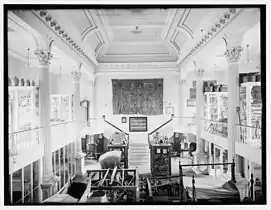Essex Institute
The Essex Institute (1848–1992) in Salem, Massachusetts, was "a literary, historical and scientific society."[1] It maintained a museum, library,[2] historic houses; arranged educational programs; and issued numerous scholarly publications. In 1992 the institute merged with the Peabody Museum of Salem to form the Peabody Essex Museum.[3]

On December 8, 2017, much to the dismay of Salem residents, Dan L. Monroe, PEM’s Rose-Marie and Eijk van Otterloo Director and CEO, issued a press release announcing that the 42,000 linear feet of historical documents will be permanently relocated to Rowley, MA and Plummer Hall and Daland House, the two historic buildings which had housed the Phillips Library, will be utilized as office and meeting space.[4]
History
The Essex Institute was "formed by the union of the Essex Historical Society and the Essex County Natural History Society."[5] Daniel Appleton White, the former Judge of Probate for Essex County, was appointed in 1848 as the first president of the institute until his death in 1861.[6] Around 1879 the institute housed its "scientific collections" in Salem's East India Marine Hall and its library in Plummer Hall.[7] According to an 1880 travel guide, "its objects are general and varied. Perhaps the most important is that of local historical discoveries and the preservation of everything relating to Essex County history."[8]
In addition to operating a library and museum, the institute arranged educational programs. In the 1880s, for example: "1. Every winter season lectures are given to an almost unlimited extent. Besides a regular course on general subjects, several courses are given on special subjects — Literature, History, Languages, Travel, the Sciences — and various papers are read before the regular meetings. 2. A regular course of musical entertainments is given every season, besides which there are several miscellaneous concerts. 3. Art exhibitions are given once or twice each year, at which are exhibited paintings, statuary, decorations, fancy work and the like by Essex county people. Also, exhibitions of horticulture and agriculture. 4. During the summer season a half dozen "field meetings" are held in different parts of the county. At these meetings addresses are made on the local history of the place visited, and on its flora and geology. In addition, it is customary to have one or more distinguished scientists or historians to speak on a specially assigned topic."[9]
By the 1930s the institute owned "two fine Samuel McIntire houses in Salem - the Peirce-Nichols House, built in 1782, and the Gardner-Pingree House, built in 1804, both ... open to the public."[10]
Images
 Plummer Hall, 19th century
Plummer Hall, 19th century East India Marine Hall, 19th century
East India Marine Hall, 19th century Essex Institute, c. 1900-1910
Essex Institute, c. 1900-1910 Essex Institute, c. 1900-1910
Essex Institute, c. 1900-1910
See also
- Peabody Essex Museum, successor to the Essex Institute (1992)
References
- Visitors' guide to Salem. Salem, MA: H.P. Ives, 1880
- Davies Project. "American Libraries before 1876". Princeton University. Retrieved April 27, 2022.
- PEM website. "Museum history." Retrieved 2011-02-16
- "Statement Regarding PEM Phillips Library". Peabody Essex Museum. Retrieved 2017-12-09.
- Massachusetts Register. 1852
- Hurd, Duane Hamilton, ed. (1888). History of Essex County, Massachusetts, with biographical sketches of many of its pioneers and prominent men. UMass Amherst Libraries. Philadelphia: J. W. Lewis & Co. pp. xxvi.
- Appleton's General Guide to the United States and Canada: New England and middle states and Canada. D. Appleton and Co., 1879
- Benjamin D. Hill, Winfield S. Nevins. The North Shore of Massachusetts Bay: An illustrated guide and history of Marblehead, Salem, Peabody, Beverly, Manchester-by-the-Sea, Magnolia, and Cape Ann, 3rd ed. Salem: Salem Observer steam press, 1880
- Hill and Nevins. 1880
- Corning. 1933
Further reading
Issued by the institute
- Proceedings of the Essex Institute. 1848-1868
- Act of incorporation, constitution and by-laws of the Essex Institute, incorporated February, 1848: With a catalogue of the officers and members. W. Ives and G.W. Pease, Printers, 1855
- Essex Institute Historical Collections. 1859-1993
- Bulletin of the Essex Institute. 1869-1898
- "Essex Institute," in: Charles Stuart Osgood, Henry Morrill Batchelder. Historical sketch of Salem, 1626-1879. Salem: Essex Institute, 1879
- Annual report of the Essex Institute. 1899-1960
About the institute
- essex institute, in: griffin. "bibliography of historical societies of the united states and british america." Annual report of the American Historical Association, 1892. Smithsonian Institution Press, 1893
- "Salem, Mass.: Essex Institute". Handbook of Learned Societies and Institutions: America. Carnegie Institution of Washington. 1908. hdl:2027/uc2.ark:/13960/t5t72q98c.
- Rea, Paul Marshall, ed. (1910), "Massachusetts: Salem: Essex Institute", Bulletin of the Buffalo Society of Natural Sciences: Directory of American Museums, vol. 10, Buffalo, New York, p. 132, hdl:2027/coo.31924061324939
{{citation}}: CS1 maint: location missing publisher (link) - Howard Corning. The Essex Institute of Salem. Bulletin of the Business Historical Society, Vol. 7, No. 5 (Oct., 1933), pp. 1–5
- Norman R. Bennett, George E. Brooks, Alan R. Booth. Materials for African History in the Peabody Museum and Essex Institute. African Studies Bulletin, Vol. 5, No. 3 (Oct., 1962), pp. 13–22
- Robert P. Spindler, Gregor Trinkaus-Randall, Prudence Backman. Format for Cooperation: Cooperative Collection Registers at the Peabody Museum of Salem and the Essex Institute. American Archivist, Vol. 51, No. 1/2 (Winter - Spring, 1988), pp. 115–119
External links
- Digital Public Library of America. Items related to Essex Institute, various dates